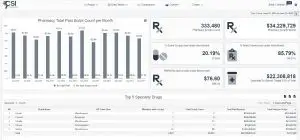The idea of asking your insurance carrier for your healthcare and claims data has been taboo for so long that it isn’t listed as an FAQ on any major fully insured carrier’s website. That’s right, in the digital age, with a wealth of information at our fingertips, it’s impossible to get your hands on actionable data when it comes to your organization’s healthcare spend.
Anthem BCBS rolled out data tools last fall to help government officials, public health figures, and employers track regional and group-specific trends as they relate to COVID-19… but where is the rest of it? As healthcare plan utilization begins to rise in areas other than COVID-19 testing, vaccinations, and care, data transparency will be more important than ever to ensure value-based healthcare.
It’s true that more data transparency is coming in the next few years, as legislation like the No Surprises Act and the Transparency in Coverage Rule take effect. But as Healthcare Business Today recently pointed out, “To truly drive value in our health care system we must marry complete price transparency across all sites of care with quality data and make that information easily accessible to the public.” So why not get ahead of the curve and get a wealth of data (including pricing and quality of care) in the meantime?
Consumers compare pricing and quality for purchases as small as their mobile phones and vacuum cleaners all the way up to their refrigerators and cars. But unless you have data transparency with analytically-derived insights, you really can’t do the same comparison shopping for a huge medical expense such as surgery, even while surgery bills generally outpace most product pricing.
Roundstone’s medical group captive delivers insightful data – a great advantage with our self-funded health insurance solution. In fact, the data transparency in our captive gives you full access to your group’s anonymized healthcare data, including industry benchmarks.
Roundstone’s health benefits plans automatically include access to your claims data–it’s not a premium feature. Eligible plans utilize one of several TPAs who send monthly claims data, which is then reported to advisors and employers via our CSI Dashboard, a business intelligence platform designed exclusively for our clients. Whether they have 20 employees or several thousand, Roundstone employers are managing healthcare costs like any other business expense, with the ability to see where every single claims dollar is spent. Now that’s powerful!
Data Transparency in Captive Healthcare: Why It Matters
How does data transparency in captives translate to savings? You can act on almost every data point displayed by Roundstone’s CSI Dashboard, for example. Track Emergency utilization, comparison shop pricing for non-emergency procedures, discover partners who will help bring costs down by passing rebates along to you, and so much more.

And what a difference data makes. Roundstone employers save an average of 20% using these resources. Unfortunately a recent strategy for many employers has been to shift more rising health benefit costs to employees in the form of increased deductibles, co-insurance and premium share. This approach is clearly not a solution that helps recruitment and retention of your workforce. The bottom line that impacts your bottom line is that the data transparency in captive healthcare plans makes it possible for you to work your costs down while providing high quality benefits for your employees. And after the year or so we’ve had as we emerge from the pandemic, a happy, healthy workforce is hard to take for granted!
Download the CSI Dashboard Fact Sheet
Interested in data analytics for your own healthcare plan?









